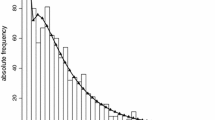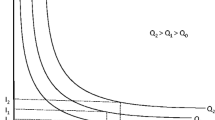Abstract
This paper provides an analysis of the relationship between research performance and individual characteristics (e.g., career path information) of researchers, based on information provided in the curriculum vitaes of 565 excellent researchers within the life sciences and medical sciences fields in Japan. I specifically analyzed the relationship between the experiences of practical physicians and research performance. As a result, I found that the experience as a practical physician had a statistically positive relationship with the number of research papers, but there was not a significant relationship with the number of citations. Moreover, the diversity of a researcher’s career related significantly to the number of citations and patents. An employment experience at a young age with a company or independent administrative agency had a significant and positive relationship with number of coauthors. However, a significant relationship between work experience in a foreign country and research performance was not observed.
Similar content being viewed by others
Notes
Clinical fields were classified as internal medicine and surgery.
Research activity includes collecting data and information associating research, data processing, measurements and experiments, and research meetings.
Diagnosis and treatment activity is included in the social services classification.
The independent administrative agency system is a system designed to give an independent corporate status to the organization. This system has aimed to improve the quality, efficiency, transparency of operations, and autonomous management.
Experience as a researcher in a research institution in a country other than Japan is referenced.
Japan Society for the Promotion of Science (JSPS) provides a special program that grants fellowships to (1) young Japanese postdoctoral researchers who conduct research activities at Japanese universities or research institutions on a non-employment basis and to (2) graduate students who conduct research in Japanese university doctoral programs. Please refer to http://www.jsps.go.jp/english/e-pd/index.html.
It includes research institute under the direct control of the administrative agency in this analysis.
This variable refers to independent administrative agencies as of October 2012, other than the incorporated national university. It includes foundations and the Inter-University Research Institute Corporation (IURIC). IURIC is classified as an independent administrative agency in this study to distinguish it from a university, though it is based on an incorporated national university. IURIC has made an important contribution to the development of Japan’s academic research by conducting effective joint research and providing researchers with benefits that are difficult for individual universities to maintain (e.g., large-scale facilities, considerable amounts of data, and academic materials).
References
Beaver, D. (2001). Reflections on scientific collaboration (and its study): Past, present, and future. Scientometrics, 52(3), 277–365.
Cañibano, C., Otamendi, J., & Andújar, I. (2008). Measuring and assessing researcher mobility from CV analysis: The case of the Romón y Cajal programme in Spain. Research Evaluation, 17(1), 17–31.
Cañibano, C., Otamendi, F., & Solís, F. (2011). International temporary mobility of researchers: A cross-discipline study. Scientometrics, 89(2), 653–675.
Dietz, J., & Bozeman, B. (2005). Academic careers, patents, and productivity: industry experience as scientific and technical human capital. Research Policy, 34(3), 349–367.
Dietz, J., Chompalov, I., Bozeman, B., Lane, E., & Park, J. (2000). Using the curriculum vitae to the study the career paths of scientists and engineers: An exploratory assessment. Scientometrics, 49(3), 419–442.
Gaughan, M. (2009). Using the curriculum vitae for policy research: An evaluation of National Institutes of Health Center and Training Support on career trajectories. Research Evaluation, 18(2), 117–124.
Gaughan, M., & Bozeman, B. (2002). Using curriculum vitae to compare some imapcts of NSF research grants with research center funding. Research Evaluation, 11(1), 17–26.
Gaughan, M., & Ponomariov, B. (2008). Faculty publication productivity, collaboration, and grants velocity: Using curricula vitae to compare center-affiliated and unaffiliated scientists. Research Evaluation, 17(2), 103–110.
Hall, B., Jaffe, A. and Trajtenberg, M. (2001). The NBER Patent Citations Data File: Lessons, Insights and Methodological Tools. NBER Working Paper, 8498.
Jonkers, K. (2011). Mobility, productivity, gender and career development of argentinean life scientists. Research Evaluation, 20(5), 411–421.
Jonkers, K., & Tijssen, R. (2008). Chinese researchers returning home: Impacts of international mobility on research collaboration and scientific productivity. Scientometrics, 77(2), 309–333.
Kanda, Y. & Kuwahara, T. (2011). Shrinking research time for university faculty members comparison of 2002 and 2008 in the “Survey on Full-Time Equivalents at Universities”, National Institute of Science and Technology Policy, Mext, Discussion Paper No.80. http://hdl.handle.net/11035/497.
Lee, S., & Bozeman, B. (2005). The impact of research collaboration on scientific productivity. Social Studies of Science, 35(5), 673–702.
Ministry of Education, Culture, Sports, Science and Technology in Japan (2008). Survey on full-time equivalents at universities (in Japanese). http://www.mext.go.jp/b_menu/houdou/21/09/icsFiles/afieldfile/2009/09/14/1283868_2.pdf.
Pao, M. (1982). Collaboration in computational musicology. Journal of the American Society for Information Science, 33(1), 38–43.
Pravdic, N., & Oluic-Vukovic, V. (1986). Dual approach to multiple authorship in the study of collaborator and scientific output relationship. Scientometrics, 10(5), 259–280.
Price, D., & Beaver, D. (1966). Collaboration in an invisible college. American Psychologist, 21(11), 1011–1018.
Sandström, U. (2009). Combining curriculum vitae and bibliometric analysis: Mobility, gender and research performance. Research Evaluation, 18(2), 135–142.
Sooryamoorthy, R. (2013). Publication Productivity and Collaboration of Researchers in South Africa: New Empirical Evidence. Scientometrics. doi:10.1007/s11192-013-0990-z. Accessed 2 March 2013.
Statistics Bureau, Ministry of International Affairs and Communications Japan (2009–2012). Report on the survey of research and development (in Japanese). http://www.stat.go.jp/english/data/kagaku/1530.htm; http://www.stat.go.jp/english/data/kagaku/; http://www.stat.go.jp/data/kagaku/kekka/kekkagai/pdf/21ke_gai.pdf; http://www.stat.go.jp/data/kagaku/kekka/kekkagai/pdf/22ke_gai.pdf; http://www.stat.go.jp/data/kagaku/kekka/kekkagai/pdf/23ke_gai.pdf; http://www.stat.go.jp/data/kagaku/kekka/kekkagai/pdf/24ke_gai.pdf
Su, X. (2011). Postdoctoral training, departmental prestige and scientist’s research productivity. The Journal of Technology Transfer, 36(3), 275–291.
Toyoda, N. (2012). Medical publication trends in japan. The Japanese Congress of Neurological Surgeons, 21(6), 446–451.
Zuckerman, H. (1967). Nobel laureates in science: Patterns of productivity, collaboration, and authorship. American Sociological Review, 32(3), 391–403.
Author information
Authors and Affiliations
Corresponding author
Rights and permissions
About this article
Cite this article
Fukuzawa, N. An empirical analysis of the relationship between individual characteristics and research productivity. Scientometrics 99, 785–809 (2014). https://doi.org/10.1007/s11192-013-1213-3
Received:
Published:
Issue Date:
DOI: https://doi.org/10.1007/s11192-013-1213-3




